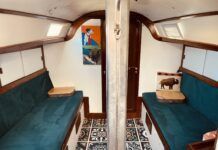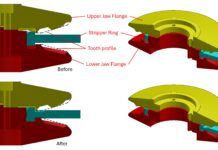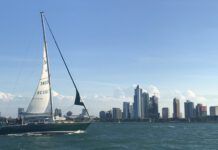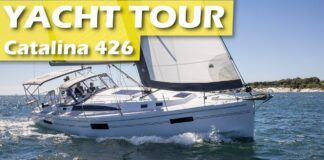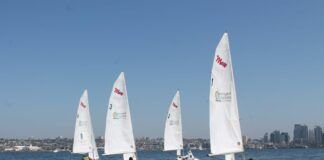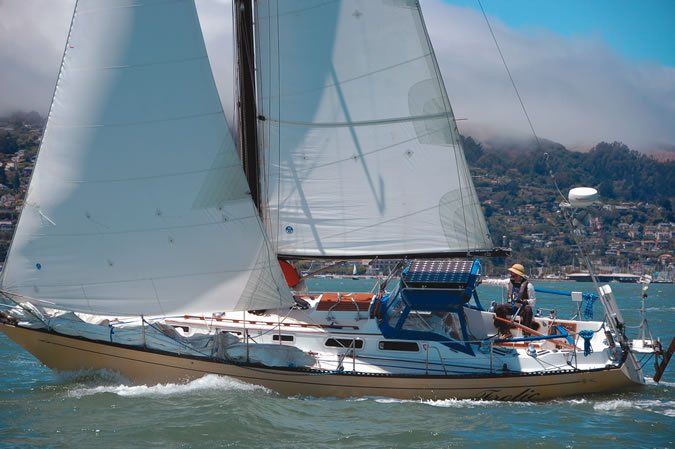
Penetrating oils
In regard to your article on freeing seized hardware (see PS January 2016 online), Ive found Kano Kroil (www.kanolabs.com) to be very effective, and I keep it on the boat. In a Practical Machinist website post (www.practicalmachinist.com) on penetrating oils, Kroil was reportedly the second best solution, after a homebrew mix of automatic transmission fluid (ATF) and acetone. Theres also a good discussion on penetrating oils in the Cruisers Forum (www.cruisersforum.com) titled Penetrating oil for old bolts/studs on exhaust manifold. I recommend readers interested in penetrating oils also check these out.
Steve Hodges
Frolic, Islander 36
Santa Barbara, Calif.
Saving the Sole
I read every PS issue as soon as it arrives, but I don’t remember seeing an article about cabin sole finishes. About 10 years ago, we refinished our boats sole with a product called Ultimate Sole, and we loved it. Upon looking again for the product to do a maintenance topcoat to restore the gloss, I learned that its no longer available. Has PS reviewed sole finishes?
Dave Carlson
Serendipity, Valiant Esprit 37
Marblehead, Mass.
We regularly receive reader inquiries about Ultimate Sole. While it was a favorite among many boat owners-and our testers really liked it too-the product ceased production when the manufacturer went out of business around 2010 or 2011. As weve noted before, Ultimate Sole had poor nonskid but was a highly durable and traditional-looking (clear) cabin-sole finish. However, one industry expert told us that there wasnt anything particularly special about the formulation and that Ultimate Sole was pretty much a hardware-store floor finish re-branded for marine use. While we were unable to confirm that information, there are marine alternatives on the market. PS editors have had good luck with Interluxs polyurethane Goldspar Satin, Pettits ZSpar Captains 2067 (clear) or 1015 (amber), and Epifanes High Gloss. The products also have scored well in our past tests for weathering outdoors, so they should have an even longer life in a cabin.
For more guidance, check out the PS Advisor articles in the December 2008 and July 2015 issues.
Stay Positive, PS
I find the habit among those in the sailing community to start a description of a boat with a negative quite off-putting. Although PS is far from the only perpetrator of this habit, you exemplify it impeccably with the caption to the lead picture of the Pacific Seacraft 31 (May 2015): Although youre unlikely to see many Pacific Seacraft 31s winning races…
No one buys a PS31 to win races, nor was it designed to do so. If it is particularly slow among the boats who have similar design goals, then by all means mention that observation, but to have the first thing read about the boat (likely the caption) highlight what it can’t do, is both unfair to the boat and far too common a habit among the sailing community.
I see the general sailing public as quite poorly educated with regard to the implications of boat design decisions, and the primary assessment by speed potential is one of the worst habits. The PS31 is designed as a voyaging boat and sounds like it goes a fair distance to meeting that goal. Along educative lines, Practical Sailor might have pointed out the wisdom of a skeg-hung rudder for a far-wandering boat and/or questioned the wisdom of in-mast furling: positions I would support and are worthy of comment.
Dick Stevenson,
Alchemy, Valiant 42
Larchmont, N.Y.
Edson Feedback
In the February 2016 article on one-step boarding aids, I couldnt help noticing the way that Edsons One-step and the Doyle Quickstep were secured when using them alongside the test boat. As pictured, the SailStep was used on center of the lifeline gate, while the other two were pinned to individual stanchion bases. It seems rather strange to test them differently.
Fairness of testing aside, it would be safer for owners to use them in way of their gate, and also with the lines spread further apart. Bringing the lines close together creates a less stable platform, while spreading them apart to the two stanchion gates (or aluminum toerail) creates a more balanced step.
Adam Cove
Vice President,
Engineering, Marketing and Technology
Edson International
We apologize if the photos in the article were misleading or caused any confusion or doubts. They were not of the actual testing procedure, but instead were used to simply show the design of the steps. In fact, the SailStep photo was supplied by the manufacturer. The products were set up as you described and were tested on several different boats.
Coppercoat
I have reviewed your bottom paint test articles. One paint that I didnt see included is Coppercoat (www.coppercoatusa.com), which claims to last 10 years, if its applied by their methods. Have you reviewed this paint? If not, do you plan to do so?
Jim Ronay
30-foot Cape Dory
Via email
Coppercoat was included in our static-panel tests in Florida in 2010 to 2011, but it was not as effective as some of the other paints after one year, and its performance declined from there. However, note that we do not scrub the static test panels, so a hull-cleaning regimen that includes scrubbing might prolong the coatings useful life. If you live in a warm climate and scrub frequently, it might endure, but just not provide very robust protection.Also, the formula may have changed in the last five years.
Well look into applying Coppercoat to a test boat and will keep readers posted.
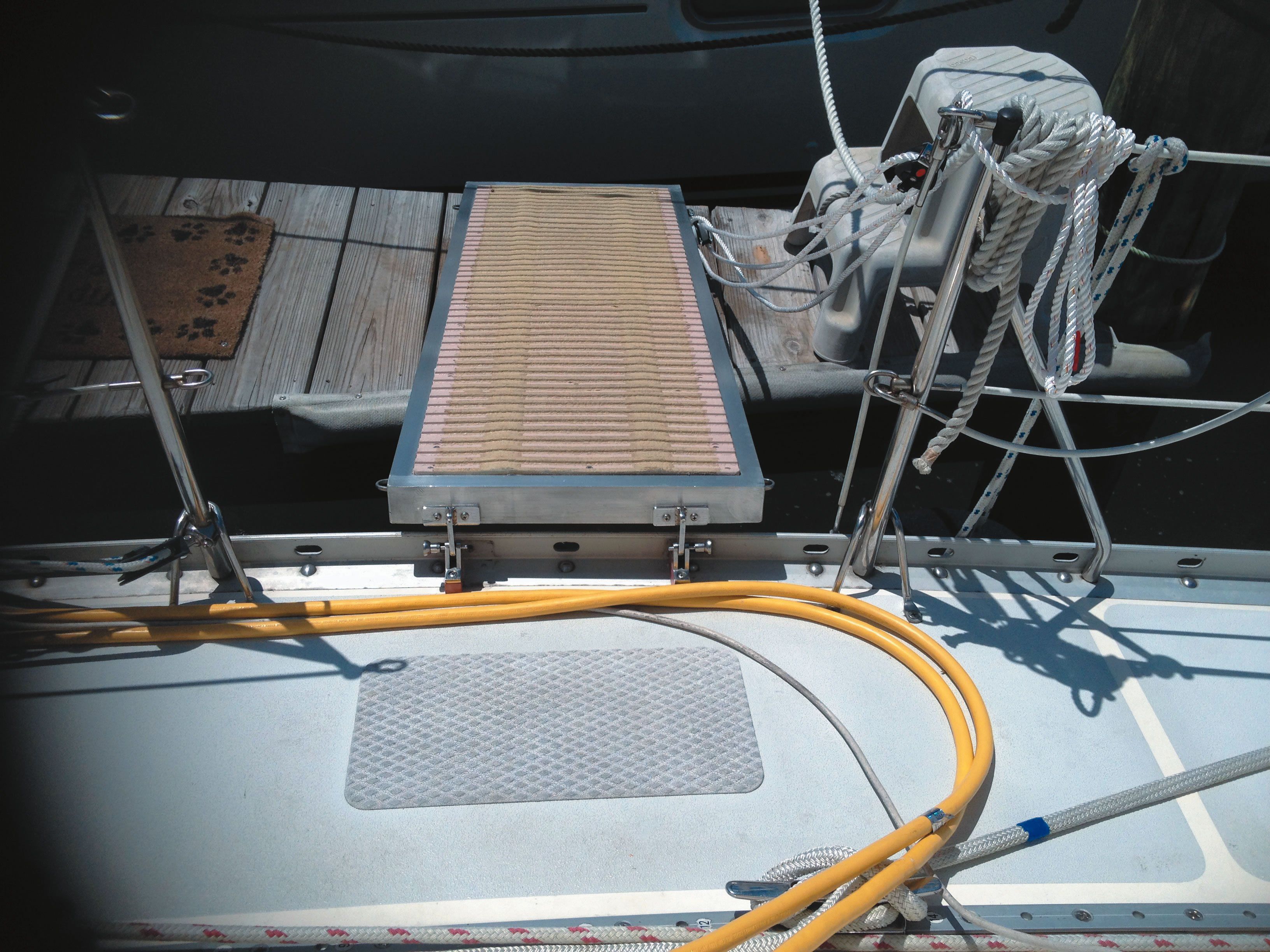
Custom Gangplank
In the February 2016 issue, you asked for readers passerelle designs, and although our design is made for a gangplank to a finger pier, I thought you might be interested.
A few years ago, we looked for a boarding solution for our 1990 Hunter Passage 42, primarily for our golden retriever, Genoa, who was unable to jump up to get aboard due to aging. (As it turns out, it is now also very useful for my wife and me.) We settled on a custom design made by Seaside Boat Works (www.seasideboatworks.com) in Annapolis, Md. It was made from a 1- by 2-inch aluminum tubing frame, a -inch fiberglass board, and the tread from a PetStep (www.petstep.com). The tread is very important and has a sticky surface with cleats embedded. It can be used at angles up to about 60 degrees (by Genoa and us).
John M. Poindexter
Vice Admiral, U.S. Navy, retired
Bluebird, Hunter Passage 42
Annapolis, Md.
Thanks for sharing your setup. Anyone designing a do-it-yourself passerelle or gangplank should be sure that the deck connection is robust and secure; that all attachments for raising and lowering the passerelle must be well reinforced; and that the passerelle is safely and securely stowed when underway. If others would like to share their tried-and-true DIY passerelle designs, please email them to [email protected].
EVO-1 Field report
I wanted to comment on your September 2015 update on the Raymarine EVO-1 autopilot.
In June 2014, in preparation for our Great Loop adventure, I upgraded my Endeavour 42 from an ST4000 Wheel Pilot to an NMEA 2000 network and all Raymarine gear-C125 multi-function display (MFD), EVO-1 Course Computer, P70 control head, ACU 400 Controller, and a Linear Drive 2.
The Raymarine devices will talk to NMEA 2000, using what I considered an inexpensive adapter cable from Raymarine (A6046 male or A6045 female) on each unit; in my case, three were needed, and the total was less than $100. Once on the network, the data was available to all connected devices, including my Maretron depth, speed and temperature gauge, my Maretron ultrasonic wind/weather station, tank level sensors, and a Noland Engineering Engine Monitor. I wanted a single network, so all data could be shared, and I found NMEA 2000 network components from Actisense and Maretron to be significantly more robust than the Seatalk components.
The system steered well for over 6,000 miles under power or sail, following a route or the wind, in rivers, lakes, and even in 7- to 10-foot seas in 30-knot-plus winds in the Gulf of Mexico. I used the Performance setting for the rivers, and Cruising setting for most lakes and the Gulf.
One thing I did find was that the Raymarine gear was more sensitive to NMEA 2000 network errors than other devices. In the Gulf, the autopilot started randomly disconnecting when following a compass course. Following a route or a wind point worked fine, but on compass course, it would drop every hour or so. After many hours of troubleshooting, the problem was traced to a cracked NMEA 2000 T-connection in the network between the EVO-1 and the ACU. All other devices reported and worked fine; there are about 20 of them and a half-dozen Ts and multiport adapters. The problem originated when a Maretron update to a tank level indicator failed, and by testing the update function on other devices, I was able to find the network issues.
Users will either love or hate the Raymarine update process; I happen to like it. The newer updates come as a system update bundle, a 2G+ download-not good for those without broadband or a Raymarine MFD. In the 18 months since installation, I have installed six updates, and each made the system better. If you have only the EVO-1, and no problems, then why update? The real bang for the buck is in the MFD changes.
Ed Mahoney
EdE J, Endeavour 42
Rocky River, Ohio
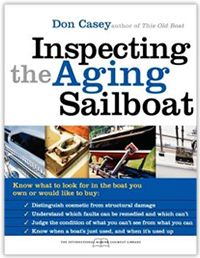
DIY Boatbuying
Do you have any past articles, books, etc. about the dos and don’ts of buying a non-brokered sailboat or without ones own broker?
Jim Stevens
Syracuse, N.Y.
In the June 2012 issue, we published DIY Survey Checklist for Used-boat Buying, which was written by PS contributor and professional surveyor Capt. Frank Lanier; that would be a good place to start your research. Another helpful resource that we recommend is Don Caseys book Inspecting the Aging Sailboat, which is available in Practical Sailors online bookstore (www.practical-sailor.com/books). Once you narrow down your search to specific boat models, be sure to look for the related used-boat review in our online archive. They often include details on the common pitfalls of specific boats and age-related construction issues, and the owners comments sections can offer insight into the pros and cons of a certain boat. An article on choosing and dealing with a broker is in the works.
Trailer Brakes
I just read your article on rebuilding the corroded trailer with a broken axle (PS January 2016), and I was disturbed by the statement that the original surge brake system is no longer part of the trailer setup. This is dangerous and possibly illegal; not something that a respected publication should be encouraging by pointing out that a rebuild can be done for $312 in parts. That is if you leave out the cost of brakes.
A Cape Dory Typhoon weighs about 2,000 pounds empty. A steel trailer for a boat that size is probably 1,000 pounds more. Trailering laws vary by state, but brakes are generally required for 3,000-pound trailers. Common tow vehicles such as pickups are not set up with brakes designed to safely stop both the truck and a brake-less trailer above a given weight. Hopefully, Ralph Naranjo will do a favor for both himself and the motoring public and fix his trailer properly.
Rich Odendahl
Harrison Township, Mich.
We agree that one needs to follow allstate and federal regulations regarding tow vehicles and trailers. The brakeless axle that the articles author, PS Technical Editor Ralph Naranjo, used and was described in the article was the factory-recommended model found on current Triad Trailers manufactured for Cape Dory Typhoons. Triad owner Mike Orro specified the brakeless axle assembly.
Other things to consider are the high rates of failure for surge andelectric/hydraulic brakes on boat trailers due tothe fact the trailers are regularly submerged in salt water. Also, using smaller vehicles to tow heavier loads because the surge-brake rating allows it can be problematic at highway speed and on mountain roads, especially if a brake malfunction occurs. Keep in mind that a long haul on a busy highway is much more demanding than a mile run down a flat, 25-mile-per-hour residential road. Follow your trailer manufacturers guidelines on regular maintenance and inspection of equipment, and in the event of refit, be sure to contact them for guidance.

















